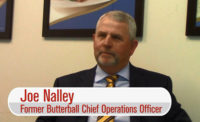Efficiency Mindset
By Barbara Young, Editor-In-Chief
Sara Lee’s processed-meat team in St. Joseph, MO, subscribes to a lean-management philosophy to achieve their waste-elimination goals.
If a picture is worth a thousand words, a single word might seem powerless. However there are words, and then there are words. Consider the Japanese word kaizen, a foreign concept gaining import in the American business lexicon.
Kaizen came up again and again on a recent visit to Sara Lee Corp.’s production site in St. Joseph, MO, dedicated to the manufacture of Ball Park hot dogs, Hillshire Farm smoked sausages, and thinly sliced deli meats under the Sara Lee and Hillshire Farm brands.
Pictures trigger mental impressions and words are necessary in human contracts, something well understood by the architects of the best-practices manual currently guiding meat-processing procedures employed at Sara Lee Corp. manufacturing sites. It does not begin and end there, however, for kaizen defines a workplace where employees from top to bottom make a difference through their participation and commitment. The method’s formula includes teamwork, improved morale, personal discipline, product quality, and suggestions for improvement.
Imagine a single word shaping attitudes concerning food safety, quality products, production efficiency, worker safety, and corporate responsibility. Translated, “kai” means to change, and “zen” means to become good.
“This is a good process for coming up with best solutions,” says John McAndrew, supply chain group vice president of operations for Sara Lee’s food-and-beverage segment under which its meat business operates. “We use this [kaizen] as one of the main tools in our lean-management process. It drives efficiencies not only in this facility, but also across the corporation. It is so fundamental yet is so powerful.”
The ultimate goal of lean production is the elimination of waste, whether it is producing too much or producing too soon, explains Brent Bliss, general manager at St. Joseph.
Others acts of waste include the following areas:
Intellect: failing to fully utilize the time and talents of people
Motion: any adding no value
Correction: any repair necessary
Processing: over-processing
Waiting: for parts or a machine to finish a cycle
Inventory: maintaining more than the minimum to get the job done
Conveyance: nonessential transport is waste
McAndrew, a Sara Lee executive stationed at the company headquarters in Downers Grove, IL, recently journeyed to St. Joseph, where he once served as general manager, to help explain the plant’s operational distinctions and features.
The plant’s achievements on the food-safety and employee-welfare fronts include a pathogen-free environment, concerning products and the plant.
Results of 12,000 samples taken in the past two years to detect the presence of pathogens confirm that the plant operates in a clean and safe environment, affirms Scott Shipferling, director of manufacturing.
“Anything that product touches or does not touch is tested for the presence of pathogens,” he explains. “That means everything, including floors, drains, walls, the air, and machines. We take further steps with our biosecurity measures to make sure nobody brings in anything from the outside. We know that soil contains pathogens. You have to control hands and feet to prevent cross-contamination.”
Biosecurity measures also include controlled and monitored entry and departure to and from the plant. Access is by a single door electronically unlocked with keycards distributed to a select number of people. Electronic keycards also control access to production areas.
Pest control is another safeguard. The fortress-like construction of the building works well at keeping pests out, Shipferling says.
The plant’s work-safety numbers stand out in the industry at a recordable rate of 1.21 against the 9.6 industry average.
“We have a strong centralized safety, environmental, and security program,” McAndrew says. “It’s a standardized process throughout the enterprise. Being a new plant, it was relatively easy to adapt to this standardized culture. The results speak for themselves.”
Although it may seem rather strange to use a Japanese word to accomplish a meat-industry goal, it makes good sense to the team members at the St. Joseph plant. The bottom line being whatever it takes to maximize human potential, product quality, operate efficiently, and reduce operating costs.
“We have kaizen events twice a month to work on eliminating waste in the business,” explains Bliss. “For example, a small team of about ten people spend nearly a week taking pieces of the production process apart and putting it back together, looking for ways to improve performance.”
More than 600 workers communicate with a grab bag filled with nouns and verbs revolving around the word kaizen. Although the grab bag is imaginary, words to work by are real and include words such as hypothesis, optimization, focus, root cause, standardized work, results, solution, opportunity, brainstorming, alternatives, and goal.
“We really are on a continuous improvement journey,” notes Bliss. “We all push each other to achieve excellence.”
Take the word “opportunity,” which for Bliss means “community involvement.” He or members of his staff participate in a variety of civic organizations as a leader or a group member. He spends about 7 percent of his time away from the plant conducting business on behalf of such organizations as the United Way, Partners in Education, Chamber of Commerce, St. Joseph community emergency response team, and the congressional manufacturing advisory council.
The Sara Lee meat-processing team operates as advocates of the business approach pioneered by the Japanese manufacturer of the Toyota line of automobiles.
The current strategy grew out of a study conducted by the Sara Lee supply-chain system and was tailored for the meat-plant operation, explains Bliss.
“Employee involvement is essential,” he says, adding that implementation requires discipline, resources, and unified commitment.
“We intend to move toward kaizens being employee led,” Bliss says. “Implementation of the concept started with our leadership, but we have been transitioning to lower-level management and production personnel. We have employees with considerable tenure, and we are pleased with their ability to contribute to the organization.”
As a scaler assigned to the plant’s clean room to conduct tests on packaged product, Patty Mooney, for one, understands the importance of strict adherence to food-safety and product-quality procedures.
The clean room is a sterile environment with restricted access. Segregating production under “hospital-like conditions” dramatically reduces potential for cross-contamination. Part of a continuous process, the clean room protects product between the time it is cooked until it is vacuum-heated and sealed in a barrier bag.
“Employment rates are dropping nationwide, but that has not affected us because we have a great workforce,” Bliss says. “One of the reasons for our presence in St. Joseph is the availability and quality of our workforce. We continue to decrease turnover, and it is lower than the industry standard. Our vision is to be the employer of choice among our employees and to provide the best work environment we can for them.”
Defined as a method of continuous incremental improvements, kaizen is an essential administrative and production tool at the St. Joseph plant, to be sure. The plant annually produces millions of pounds of a variety of smoked sausages, hot dogs, and deli meats destined for supermarket sales.
About four years ago, the leadership of the Sara Lee manufacturing operation latched onto lean manufacturing to symbolize a corporate call-to-arms for developing an operating distinction in a marketplace abundant with all manner of meat product choices.
“Kaizen is a method of bringing people together from multiple disciplines to work on specific problems thereby unleashing the potential of the group,” McAndrew explains.
Lean management — essentially the removal of waste at all levels to reduce operating costs — is the guiding principle behind the company’s long-term financial goals.
“We are even sending less solid waste to landfills,” McAndrew says.
For the team in charge of production at the St. Joseph plant, one of the company’s newest and most modern facilities, lean management means establishing exemplary quality controls governing all aspects of production, beginning before the arrival of beef, pork, and poultry raw material.
“We monitor our suppliers [of raw meat] regularly, and strategically partner with key suppliers to ensure consistent quality,” McAndrew says.
The plant operates in a business park. Besides a university campus, its non-meat business neighbors include a newspaper, various distributors, a plastic-molding manufacturer, and warehousing, positioning it among the few other such operations in similar locations throughout America.
“You would not think this is a meat plant just by the looks of the building,” McAndrew points out.
The 70-acre site in Missouri’s sixth-largest city and America’s Heartland is more than a meat-processing complex. It is a place simmering with fresh ideas.
Based on its physical features, it is less industrial in appearance and design than some traditional meat-processing plants. The building facade sports modern panels of endurable metal marrying esthetics with functionality. The relatively new structure, built in 2000, is airy and light inside with wide hallways and skylights throughout non-manufacturing areas. Production space features total separation — including two separate employee-welfare areas — between the raw-material preparation and ready-to-eat sides to avoid cross-contamination pitfalls.
“We grind, season, cook, and pack product in what we consider essentially two plants in one,” McAndrew notes.
Although the limited-access clean room is the foundation of the food-safety program, other measures include special color-coded attire worn in designated processing areas.
How does a Japanese management concept that created a new definition of profitability in the automobile industry produce similar results in meat-processing business?
In St. Joseph, the answer is in the attention to details concerning people, products, and community service.
As a corporation, Sara Lee embarked on a transformational journey in 2005, searching for improved performance and better positioning to achieve long-term growth. Its overall meat-manufacturing business ended the company’s 2005 fiscal year by generating more than $100 million in savings over a two-year period.
For its part, the St. Joseph complex contributed to the reduced operating cost through diligence at the plant level.
“This plant sets the gold standard for food safety, personal safety, product quality, and production efficiency,” McAndrew concludes. NP



Report Abusive Comment